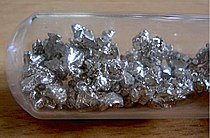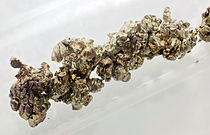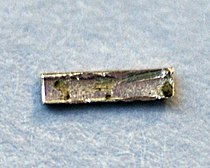鹼土金屬
鹼土金屬是指在元素週期表中同屬第2族(舊稱ⅡA族)的六個金屬元素:鈹(Be)、鎂(Mg)、鈣(Ca)、鍶(Sr)、鋇(Ba)、鐳(Ra),[1]其中鐳具有放射性。
鹼土金屬有相似的性質:標準情況下,它們都是銀白色的、閃亮、高反應性[2] 且比較軟的金屬 ,密度比其他金屬小。鹼土金屬在化合物中是以+2的氧化態存在。[3]鹼土金屬原子失去電子變為陽離子時,最外層一般是8個電子,但鈹離子最外層只有2個電子。
鹼土金屬對水的溶解度低,且都是活潑金屬、強電離[2],但仍不如鹼金屬般活潑。
在結構上,它們(與氦一起)共同具有一個全充滿的s軌道。 [2][4][5] 也就是說,該完整的軌道包含兩個電子,而鹼土金屬容易失去該兩個電子,以氧化態+2 的陽離子出現。 [3]
目前,所有已被發現的鹼土金屬均存在於自然界中,儘管鐳僅作為鈾和釷衰變鏈的中間衰變產物在地殼中微量存在。 [6]為了合成出可能是該族下一個成員的120號元素,科學家們嘗試了多次實驗,不過目前都以失敗告終。
性質
編輯物理性質
編輯鹼土金屬均為銀白色、較軟的固體,具有相對較低的密度、熔點以及沸點。
下表總結了鹼土金屬的物理性質和原子性質。
|
元素名稱 |
主要化合價 |
硬度(金剛石=10) |
單質沸點(℃) |
焰色試驗結果 | ||||||
|---|---|---|---|---|---|---|---|---|---|---|
| 鈹 | Be | 0.105 | +2 | 固體 | 1.848 | 5.5 | 1278 | 2970 | 1.5 | 無焰色 |
| 鎂 | Mg | 0.150 | +2 | 固體 | 1.738 | 2.5 | 650 | 1090 | 1.2 | 無焰色 |
| 鈣 | Ca | 0.180 | +2 | 固體 | 1.55 | 1.75 | 842 | 1484 | 1.0 | 磚紅色[2] |
| 鍶 | Sr | 0.200 | +2 | 固體 | 2.63 | 1.5 | 777 | 1382 | 1.0 | 紅色[2] |
| 鋇 | Ba | 0.215 | +2 | 固體 | 3.510 | 1.25 | 727 | 1870 | 0.9 | 蘋果綠[2] |
| 鐳 | Ra | 0.215 | +2 | 固體 | 5.000 | 1.03 | 700 | 1737 | 0.9 | 紅色 |
化學性質
編輯| Z | 元素 | 核電外子構型 | 電子排布[註解 1] |
|---|---|---|---|
| 4 | 鈹 | 2, 2 | [He] 2s2 |
| 12 | 鎂 | 2, 8, 2 | [Ne] 3s2 |
| 20 | 鈣 | 2, 8, 8, 2 | [Ar] 4s2 |
| 38 | 鍶 | 2, 8, 18, 8, 2 | [Kr] 5s2 |
| 56 | 鋇 | 2, 8, 18, 18, 8, 2 | [Xe] 6s2 |
| 88 | 鐳 | 2, 8, 18, 32, 18, 8, 2 | [Rn] 7s2 |
- 鈹以外的鹼土金屬都能和水發生反應,生成氫氣和鹼性的氫氧化物。鹼土金屬和水的反應較鹼金屬與水的反應來的溫和,不像鹼金屬在室溫中就會和水劇烈反應。而鎂和冷水反應緩慢,在熱水或水蒸汽才較為劇烈,鈣、鍶、鋇、鐳在常溫下可以和冷水劇烈反應。
例子: Ca+2 H2O=Ca(OH)2+H2
- 鹼土金屬都能在空氣中燃燒,主要產生氧化物,以下為鹼土金屬還原氧氣(O2)的方程式:
鎂還能形成氮化物(氮化鎂),鋇和氧氣加熱下反應除了得到氧化鋇,還能得到過氧化鋇(過氧化鋇可以吸氧、放氧,用來提取大氣中的氧氣[9])。
化合物性質
編輯氫化物
編輯鹼土金屬的離子氫化物是強還原劑,其和水的反應方程式通式為:
- MgH2 + 2 H2O → Mg(OH)2 + 2 H2↑[10]
鹵化物
編輯放射性
編輯除鎂和鍶外所有鹼土金屬在自然界中都至少存在着一個放射性同位素,其中鈹-7、鈹-10、鈣-41和鐳-226是微量放射性同位素。鈣-48和鋇-130由於有很長的半衰期,因此它們都以一定的量存在於大自然中。鐳在自然界中沒有穩定的同位素,含量最多的是具放射性的鐳-226。
蘊藏量
編輯鈣和鎂在地殼中十分常見,它們分別是現時地球上蘊藏量第五多和第八多的元素。這兩個元素在地殼中形成數種的礦物,如白雲石、石灰石和方解石等。其他非放射性的鹼土金屬在地球的蘊藏量較少,但也形成一些礦物,如綠柱石(鈹)、天青石(鍶)和重晶石(鋇)等。[11]放射性元素鐳最長的半衰期只達1601年,因此它只能由其他較重的元素經放射性衰變所得,從而少量地出現在大自然中,如瀝青鈾礦等放射性礦物中便可能含有鐳。
應用
編輯鈹主要用於軍事工業[12],但鈹還有其他用途。鈹在電子科技方面被用作3-5族化合物半導體的P型摻雜物[13],而氧化鈹被用作高強度的電絕緣體和導熱體[14]。由於鈹剛性高、密度低,在很大的溫度範圍內都可穩定保持形狀,所以在國防及航空航天工業中可做輕質結構部件材料。[15][16]
鎂的用途十分廣泛。它的主要用途是:製造鋁合金、壓模鑄造(與鋅形成合金)[17]、鋼鐵生產中脫硫處理、克羅爾法製備鈦等。[18]此外,利用鎂易於氧化的性質,可用於製造許多純金屬的還原劑。也可用於閃光燈、吸氣器、煙花、照明彈等。
由於鈣的高活性,因此可用作合金的脫氧劑,以及油類的脫水劑等,另外鈣也用作從礦石中分離出其他金屬(例如鈾等)的還原劑。鈣也可用於生產多種金屬的合金,例如鋁和銅合金。此外鈣在乾酪、砂漿和水泥的生產中也有起作用。[19]
鍶和鋇的用途不及前三種較輕的鹼土金屬,但它們仍有用處。碳酸鍶常用於製造紅色煙花[20],純鍶則用於研究神經元中神經傳遞物的釋放等。[21][22] 放射性同位素鍶-90的衰變熱常作為蘇聯/俄羅斯式放射性同位素熱電機的熱源(通常是以氟化鍶的形式)。[23][24]純鋇或鋇鋁合金可用於吸收真空管(如電視映像管)中的多餘氣體。[11]硫酸鋇常用於石油和天然氣井中的鑽井液[5][11][25],或用作消化道X光成像中的放射性造影劑,以及製造名為立德粉的白色顏料等。
由於鐳具有放射性,因此在現今的用途並不廣。但鐳在過去有着許多應用。鐳曾經常用於發光塗料中[26],無知的人們甚至經常將鐳添加到飲用水、牙膏和許多其他產品中,認為放射線可以促進健康,直到他們發現放射線對人體的致命危害時才逐漸停止使用。[27][28]現今鐳被少量地用作工業及醫療上的放射源,但也多被其他更強大且更安全的放射性同位素所取代。[29][30]
在生物圈的位置
編輯註解
編輯參考文獻
編輯- ^ 國際純粹與應用化學聯合會 (2005). 無機化學命名法 (IUPAC 2005年推薦). Cambridge (UK): RSC–IUPAC. ISBN 0-85404-438-8. pp. 51. 電子版。.
- ^ 2.0 2.1 2.2 2.3 2.4 2.5 Royal Society of Chemistry. Visual Elements: Group 2–The Alkaline Earth Metals. Visual Elements. Royal Society of Chemistry. [13 January 2012]. (原始內容存檔於5 October 2011).
- ^ 3.0 3.1 Greenwood, Norman Neill; Earnshaw, Alan. Chemistry of the elements. 2016. ISBN 978-0-7506-3365-9. OCLC 1040112384 (英語).
- ^ Periodic Table: Atomic Properties of the Elements (PDF). nist.gov. National Institute of Standards and Technology. September 2010 [17 February 2012]. (原始內容存檔 (PDF)於2012-08-09).
- ^ 5.0 5.1 Lide, D. R. (編). CRC Handbook of Chemistry and Physics 84th. Boca Raton, FL: CRC Press. 2003.
- ^ Abundance in Earth's Crust. WebElements.com. [14 April 2007]. (原始內容存檔於9 March 2007).
- ^ 《無機化學》.高等教育出版社.第10章 鹼金屬和鹼土金屬元素.10.2 鹼金屬和鹼土金屬的性質
- ^ 存档副本. [2020-07-01]. (原始內容存檔於2020-07-01).
- ^ Holleman, A. F.; Wiberg, E. "Inorganic Chemistry" Academic Press: San Diego, 2001. ISBN 0-12-352651-5.
- ^ 《無機化學》.高等教育出版社.第10章 鹼金屬和鹼土金屬元素.10.3 氫化物
- ^ 11.0 11.1 11.2 Kresse, Robert; Baudis, Ulrich; Jäger, Paul; Riechers, H. Hermann; Wagner, Heinz; Winkler, Jocher; Wolf, Hans Uwe. Barium and Barium Compounds. Ullman, Franz (編). Ullmann's Encyclopedia of Industrial Chemistry. Wiley-VCH. 2007. ISBN 978-3527306732. doi:10.1002/14356007.a03_325.pub2.
- ^ Petzow, G. N.; Aldinger, F.; Jönsson, S.; Welge, P.; Van Kampen, V.; Mensing, T.; Brüning, T. Beryllium and Beryllium Compounds. Ullmann's Encyclopedia of Industrial Chemistry. 2005. ISBN 3527306730. doi:10.1002/14356007.a04_011.pub2.
- ^ Diehl, Roland. High-power diode lasers. Springer. 2000: 104. ISBN 3-540-66693-1.
- ^ Purdue engineers create safer, more efficient nuclear fuel, model its performance. Purdue University. 27 September 2005 [18 September 2008]. (原始內容存檔於27 May 2012).
- ^ Davis, Joseph R. Beryllium. Metals handbook . ASM International. 1998: 690–691. ISBN 978-0-87170-654-6.
- ^ Schwartz, Mel M. Encyclopedia of materials, parts, and finishes. CRC Press. 2002: 62. ISBN 1-56676-661-3.
- ^ Baker, Hugh D. R.; Avedesian, Michael. Magnesium and magnesium alloys. Materials Park, OH: Materials Information Society. 1999: 4. ISBN 0-87170-657-1.
- ^ Amundsen, K.; Aune, T. K.; Bakke, P.; Eklund, H. R.; Haagensen, J. Ö.; Nicolas, C.; Rosenkilde, C.; Van Den Bremt, S.; Wallevik, O. Magnesium. Ullmann's Encyclopedia of Industrial Chemistry. 2003. ISBN 3527306730. doi:10.1002/14356007.a15_559.
- ^ Lide, D. R. (編), CRC Handbook of Chemistry and Physics 86th, Boca Raton (FL): CRC Press, 2005, ISBN 0-8493-0486-5
- ^ Moreno, Teresa; Querol, Xavier; Alastuey, Andrés; Cruz Minguillón, Mari; Pey, Jorge; Rodriguez, Sergio; Vicente Miró, José; Felis, Carles; Gibbons, Wes. Recreational atmospheric pollution episodes: Inhalable metalliferous particles from firework displays (PDF). Atmospheric Environment. 2007, 41 (5): 913 [2019-10-03]. Bibcode:2007AtmEn..41..913M. doi:10.1016/j.atmosenv.2006.09.019. hdl:10261/185836. (原始內容存檔 (PDF)於2020-03-13).
- ^ Miledi, R. Strontium as a Substitute for Calcium in the Process of Transmitter Release at the Neuromuscular Junction. Nature. 1966, 212 (5067): 1233–4. Bibcode:1966Natur.212.1233M. PMID 21090447. doi:10.1038/2121233a0.
- ^ Hagler D.J., Jr; Goda Y. Properties of synchronous and asynchronous release during pulse train depression in cultured hippocampal neurons. J. Neurophysiol. 2001, 85 (6): 2324–34. PMID 11387379. doi:10.1152/jn.2001.85.6.2324.
- ^ Standring, WJF; Selnæs, ØG; Sneve, M; Finne, IE; Hosseini, A; Amundsen, I; Strand, P, Assessment of environmental, health and safety consequences of decommissioning radioisotope thermal generators (RTGs) in Northwest Russia (PDF) (StrålevernRapport 2005:4), Østerås: Norwegian Radiation Protection Authority, 2005 [2019-10-03], (原始內容存檔 (PDF)於2016-03-03)
- ^ Power Sources for Remote Arctic Applications (PDF). Washington, DC: U.S. Congress, Office of Technology Assessment. June 1994 [2019-10-03]. OTA-BP-ETI-129. (原始內容存檔 (PDF)於2020-03-08).
- ^ Jones, Chris J.; Thornback, John. Medicinal applications of coordination chemistry. Royal Society of Chemistry. 2007: 102. ISBN 978-0-85404-596-9.
- ^ Terrill Jr, JG; Ingraham Sc, 2nd; Moeller, DW. Radium in the healing arts and in industry: Radiation exposure in the United States. Public Health Reports. 1954, 69 (3): 255–62. JSTOR 4588736. PMC 2024184 . PMID 13134440. doi:10.2307/4588736.
- ^ Mass Media & Environmental Conflict – Radium Girls. [2009-08-01]. (原始內容存檔於2009-07-21).
- ^ Gray, Theodore. The Elements: A Visual Exploration of Every Known Atom in the Universe. New York: Black Dog & Leventhal Publishers. 2009. ISBN 978-1-57912-814-2.
- ^ Committee On Radiation Source Use And Replacement, National Research Council (U.S.); Nuclear And Radiation Studies Board, National Research Council (U.S.). Radiation source use and replacement: Abbreviated version. January 2008: 24. ISBN 978-0-309-11014-3. (原始內容存檔於2015-09-05).
- ^ Bentel, Gunilla Carleson. Radiation therapy planning. 1996: 8. ISBN 978-0-07-005115-7. (原始內容存檔於2015-09-05).
- ^ Jakubke, Hans-Dieter; Jeschkeit, Hans (編). Concise Encyclopedia Chemistry. trans. rev. Eagleson, Mary. Berlin: Walter de Gruyter. 1994.
參見
編輯| 左方一族: | 鹼土金屬 第2族(ⅡA) |
右方一族: |
| 1族元素 | 3族元素 |





